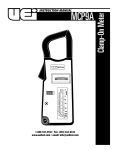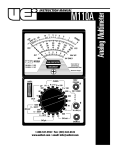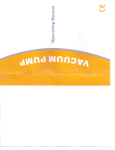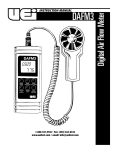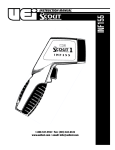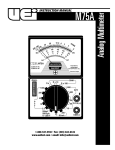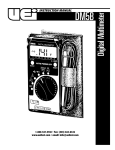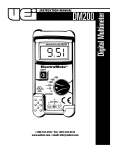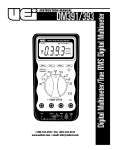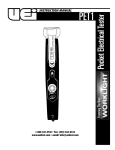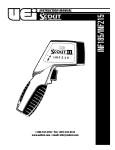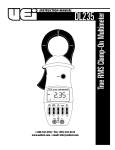Download INSTRUCTION MANUAL - Calright Instruments
Transcript
INSTRUCTION MANUAL MCP4 1-800-547-5740 • Fax: (503) 643-6322 www.ueitest.com • email: [email protected] Introduction The MCP4 includes 5 amperage ranges to give you precise readings on low or high amp circuits. It also includes volts and ohms readings to give you the complete picture of your circuit path. Features include • 10 ranges • 300 Amps AC • 750 Volts AC • Resistance to 1000 ohms • Color-coded, high res scale-plate • Pointer-lock switch (data hold) • 1-1/4” jaw capacity Safety Notes Before using this meter, read all safety information carefully. In this manual the word "WARNING" is used to indicate conditions or actions that may pose physical hazards to the user. The word "CAUTION" is used to indicate conditions or actions that may damage this instrument. • Always follow industry standard safety practices including protective clothing, gloves and safety glasses when appropriate • Do not attempt to measure any voltage that exceeds the ca t e g o rybased rating of this meter • Do not attempt to use this meter if either the meter or the test leads have been damaged. Turn it in for repair at a qualified repair facility • Ensure meter leads are fully seated by making a quick continuity check of the leads prior to making voltage measurements • Keep your fingers away from the test lead’s metal probe contacts when making measurements. Always grip the leads behind the finger guards molded into the probes • Use a current clamp adapter when measuring current that may exceed 10 amps. See the accessories in UEi’s full-line catalog • Do not open the meter to replace batteries or fuses while the probes are connected WARNING! Exceeding the specified limits of this meter is dangerous and can expose the user to serious or possibly fatal injury. • Voltages above 60 volts DC or 25 volts AC may constitute a serious shock hazard • Always turn off power to a circuit (or assembly) under test before cutting, unsoldering, or breaking the current path Even small amounts of current can be dangerous • Always disconnect the live test lead before disconnecting the common test lead from a circuit • In the event of electrical shock, ALWAYS bring the victim to the emergency room for evaluation, regardless of the victim’s apparent recovery - Electrical shock can cause an unstable heart rhythm that may need medical attention MCP4-MAN • Higher voltages and currents require greater awareness of physical safety hazards - Before connecting the test leads; turn off power to the circuit under test; set the meter to the desired function and range; connect the test leads to the meter first, then to the circuit under test. Reapply power • If any of the following indications occur during testing, turn off the power source to the circuit under test: • Arcing • Flame • Smoke • Extreme Heat • Smell of Burning Materials • Discoloration or Melting of Components CAUTION! Do not attempt to remove the meter leads from the circuit under test. The leads, the meter, or the circuit under test may have degraded to the point that they no longer provide protection from the voltage and current applied. If any of these erroneous readings are observed, disconnect power immediately and recheck all settings and connections Controls and Indicators 1. Selector Switch: Is used to select the circuit function and range. It is good practice to start with the highest range setting of the “SELECTOR” switch for a particular function if the magnitude of the function is unknown. 2. OHM ADJ: Used only on the “OHMS” function. The purpose of this control is to calibrate the MCP9A to compensate for changes in the voltage of the internal 1.5 V battery. 3. Lock Switch: Is located at the upper left side of the scale plate. It is used to secure the pointer at the last reading when measurements must be made in a confined or difficult-to-read location. 4. Mechanical Zero Adjust: Is a plastic screw located on the meter face just beneath the “LOCK” switch. This adjustment is used to set the pointer to the zero index mark at the left side of the scale plate. 5. Input Jacks: Are a special twist lock banana type. The twist lock feature prevents the test leads from accidentally separating from the jacks during the taking of AC Voltage measurements. 6. Volts: The jacks located on the left side of the MCP4 are used for taking AC and DC Voltage measurements. 7. OHMS: The jacks located on the right side of the MCP4 are used for taking resistance measurements. P. 1 Operating Instructions Measuring AC Current When measuring current, always be sure the “SEL ECTOR” switch is set to the appropriate AMP range. When in doubt, always use the highest current range first. The switch can always be reset to a lower range for a more precise reading. AC current measurements are made on the red A MP scales on the scale plate. Clamp the jaw of the MCP4 around a single circuit wire. NOTE: Clamp only one wire at a time for measurement. If two or more wires are clamped together, the tester will not read. Measuring Temperature Set the MCP4 to the “R x 10 0 / TEMP” range. Insert both of the black plugs on the temperature probe into the “OHM” input jacks on the MCP4. Adjust the green “OHM ADJ” control on the left side of the instrument until the pointer is set on the green numeral 0. NOTE: If this adjustment cannot be made refer to the “MAINTENANCE” section To make the temperature measurement, remove one of the black t e m p e rature probe plugs from the input jack and insert the red t e m p e rature probe plug. The measured temperature will be read directly from the blue temperature scale on the scale plate. If the measured value on the meter scale is less than the full scale value of the next lower range, reset the “SEL ECTOR” switch to the lower range for a more accurate reading. Slide P OINTER LOCK switch toward the right to lock the pointer at its indicating point when readings must be made in a confined or difficult-toread loca t i o n . Measuring AC Voltage When measuring voltage be sure the “SEL ECTOR” switch is set to the appropriate Volt range. When in doubt, always use the highest Volt ra n g e first. The switch can always be set to a lower range for a more precise reading. AC voltage measurements are made on the red Volt scales. Insert the red and black test leads into the “VOLT” input jacks. Connect the two test leads to the circuit under test. Measuring DC Voltage The MCP4 has one DC Volt range which can measure up to 75 Volts. DC Voltage is read on the red 750 scale and divided by 10. Observe the proper polarity in the voltage input jacks. Red test lead to “+”, black test lead to “-”. Measuring Resistance WARNING! Remove all power to the circuit under test when making resistance measurements. If any voltage is present in the test circuit an erroneous reading will result and the MCP4 fuse may open. Maintenance Periodic Service WARNING! Repair and service of this instrument is to be performed by qualified personnel only. Improper repair or service could result in physical degradation of the meter. This could alter the protection from electrical shock and personal injury this meter provides to the operator. Perform only those maintenance tasks that you are qualified to do. These guidelines will help you attain long and reliable service from your meter: • Calibrate your meter annually to ensure it meets original performance specifications • Keep your meter dry. If it gets wet, wipe dry immediately. Liquids can degrade electronic circuits • Whenever practical, keep the meter away from dust and dirt that can cause premature wear • Although your meter is built to withstand the rigors of daily use, it can be damaged by severe impacts. Use reasonable caution when using and storing the meter Insert the red and black plug ends of the test leads into the “Ω” input jacks. Cleaning Periodically clean your meter’s case using a damp cloth. DO NOT use abrasive, flammable liquids, cleaning solvents, or strong detergents as they may damage the finish, impair safety, or affect the reliability of the structural components. Select the resistance range to be used. Clean the input terminals as follows: Touch the free ends of the test leads together. The pointer will swing to the right hand side of the scale. Adjust the green “OHM ADJ” control on the left side of the instrument until the pointer is set on the green numeral 0. NOTE: If this adjustment cannot be made refer to the “MAINTENANCE” section. Re-zero the MCP9A each time that the tester is used for making resistance measurements. 1. Turn the meter off and remove all test leads. 2. Shake out any dirt that may be in the terminals. 3. Soak a new swab with alcohol and work the swab around in each terminal. To make the resistance measurement, connect the free ends of the test leads across the element to be measured. The measured resistance value will be the green numeral indicated on the “OHMS” scale. MCP4-MAN P. 2 Battery Replacement The purpose of the internal 1.5 V, size “AA”, battery is to supply power tot he circuit under test while making resistance measurements. Eventually the battery will age to the point where it will not be possible to zero the meter with the “OHM ADJ” control. When this happens the battery should be replaced. Observe the proper battery polarity when replacing the battery. It is recommended that the battery be removed if the MCP9A is not to be used for a long period of time. Remove the battery compartment cover for access to the battery. Optional Accessories Optional Battery 1.5V, size “AA” . . . . . . . . . . . . . . . . . . . . . . . . . . . . . . . . .AB1 Fuse 0.5 Amp, 0.5 OHM . . . . . . . . . . . . . . . . . . . . . . . . . . . . . . . .AF3 Test leads . . . . . . . . . . . . . . . . . . . . . . . . . . . . . . . . . . . . . . . . . . .ATL50 Temperature probe . . . . . . . . . . . . . . . . . . . . . . . . . . . . . . . . . . . .ATT28 Alligator clip adapters, insulated (pr) . . . . . . . . . . . . . . . . . . . . .AAC Plug-in line splitter . . . . . . . . . . . . . . . . . . . . . . . . . . . . . . . . . . . .ASL1 WARNING! Disconnect the test leads from the circuit under test and from the meter prior to removing or installing batteries. WARNING! Under no circumstances should you expose batteries to extreme heat or fire as they may explode and cause injury. Fuse Replacement The fuse is in series with the “OHM” circuit. If this fuse is open the OHM circuit will not work. When replacing the fuse be sure to replace it with a fuse of the same current rating and internal resistance. The use of a fuse with a different internal resistance may cause the accuracy of thee “OHMS” scale to be off. Remove the screws in the rear of the case for access to the fuse. Fuse should be 0.5 Amp / 0.5 OHM resistance. Mechanical Zero Adjust The pointer is set to register 0 at the left edge of the scale when there is no input to the MCP4 and it is laying face up on a flat surface. If the pointer does not register 0, it may be reset to that position by carefully adjusting the black screw in the meter face, just below the “LOCK” switch. Specifications Ranges AC Amps 0 - 6, 15, 60, 150, 300A AC Volts 0 - 150, 300, 750V DC Volts 0 - 75V OHMS X1, X100 (30Ω center scale) Temperature -50˚ to 400˚F Accuracy AC Amps ±3% of full scale AC Volts ±3% of full scale DC Volts ±3% of full scale OHMS ±3% of scale length General Jaw opening 1 - 1/4” Battery One 1.5 V, size “AA” (NEDA #15D) battery supplied Fuse 0.5 Amp 0.5 OHM (size 5 x 20 mm) Size 7.75” x 3” x 1.4” (199 mm x 76 mm x 36 mm) Weight 12 ounces MCP4-MAN P. 3 MCP4 Clamp-On Meter Limited Warranty The MCP4 is warranted to be free from defects in materials and workmanship for a period of three years from the date of purchase. If within the warra n ty period your instrument should become inoperative from such defects, the unit will be repaired or replaced at UEi’s option. This warra n ty covers normal use and does not cover damage which occurs in shipment or failure which results from alteration, tampering, accident, misuse, abuse, neglect or improper maintenance. Batteries and consequential damage resulting from failed batteries are not covered by warra n ty. Any implied warranties, including but not limited to implied warranties of merchantability and fitness for a particular purpose, are limited to the express warranty. UEi shall not be liable for loss of use of the instrument or other incidental or consequential damages, expenses, or economic loss, or for any claim or claims for such damage, expenses or economic loss. A purchase receipt or other proof of original purchase date will be required before warra n ty repairs will be rendered. Instruments out of warra n ty will be repaired (when repairable) for a service charge. Return the unit postage paid and insured to: 1-800-547-5740 • FAX: (503) 643-6322 www.ueitest.com • Email: [email protected] This warranty gives you specific legal rights. You may also have other rights which vary from state to state. PLEASE RECYCLE Copyright © 2007 UEi MCP4-MAN 1/07





